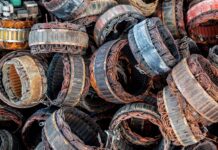What cable you should use to connect a VFD to a Motor
Over the last decade, VFDs have become an increasingly popular method of energy conservation in relation to many motor driven applications. With these technological advancements come a new set of challenges that need to be addressed. Throughout this article we will address the problems that can result from improper cable selection, how they can be solved with proper cabling, and what to look for in high quality VFD cable.
Improper Vs. Proper Cabling
Improper cabling from your VFD to your motor can cause electromagnetic interference (EMI) from the high voltage spikes your VFD creates during every day use. These voltage spikes can induce currents and voltages into adjacent circuits and systems, as well as cause radio frequency interference. Poor cabling can exacerbate these problems as well as create common mode voltages that can harm motor bearings.
Proper VFD-to-Motor cabling can minimize injected ground current for electronics reliability, minimize cross-talk induced voltages on adjacent cables for noise immunity and safety, and reduce bearing currents created by common mode current.
Shielding
Proper VFD cable shielding provides a low-impedance path to ground. Shielding serves the double purpose of keeping noise generated by VFDs from escaping the cable and preventing outside noise from being picked up.
There are three types of shielding available on the market today:
- Foil: Uses a thin layer of aluminum that is laminated to a substrate to add ruggedness and strength. It provides 100% coverage of the conductors, but is hard to work with when attaching to a connector.
- Woven Braid: Provides a low resistance path to ground and is much easier to attach to a connector than foil. It typically provides 70-95% coverage of conductors. The copper used in woven braids is more conductive than aluminum and the braid is bulkier for conduction of noise. It is very effective, but adds size and cost to the cable.
- Combination Foil/Braid: This application helps to overcome the weaknesses of each type of shielding by using the strengths of the other. These types of shields return excess noise back to the drive, which in turn, keep the motor and nearby equipment running properly.
Shape
Round, symmetrical cable performs the best under VFD to Motor circumstances. This shape creates a more uniform electrical characteristic in the cable.
Insulation
Your VFD cable insulation should be resistant to harsh industrial environments and have excellent dielectric properties to prevent breakdown from stressors like high voltage and current spikes, corona discharges, and so forth. It should be able to withstand grit, humidity, sunlight, oil, etc., but still be flexible enough to install and move easily.
Cross-linked polyethylene (XLPE) insulation is the best choice when compared to regular PVC/nylon insulation. XLPE insulation helps reduce the potential effects of harmonics and corona discharge. It also provides stable electrical performance which can extend the life of your cable. XLPE can withstand voltages up to 3x higher than PVC. This allows for longer cable runs, better motor protection, and increased efficiency of power transfer from the motor to the drive.
Grounding
The more copper there is at ground potential, the more effective the cable will be. The best choice of VFD cable includes three phase conductors, one overall shield, and three symmetrical grounds. There are cables available on the market that only utilize one ground, but these are not recommended for 2-level drives under 690V and are only seen as “marginally acceptable” to “acceptable” choices for higher level drives. Three ground cables are seen as “good” choices for all drives.
A proper VFD cable cross section should look like this, where the green circles represent the grounding wires:


Proper VFD to motor cabling can help to eliminate EMI and voltage spike problems with your VFD and motor, as well as the surrounding electronic equipment.
Got More VFD or Motor Questions? We Can Help!
Call 800-595-5315 Or Connect With Our Expert Technicians Here:
Other Articles
- What is Right for Your System – Deraggers or VFDs?
- Convention Center Saves 8% in Energy Usage
- Local University Uses EMC VFDs to Keep Facilities Running



Director of Motor Service
Josh has over 20 years of experience in electric motor repair, as well as welding and machining. He is also an expert mechanic. He is in charge of our motor service centers in all 5 EMC locations.






